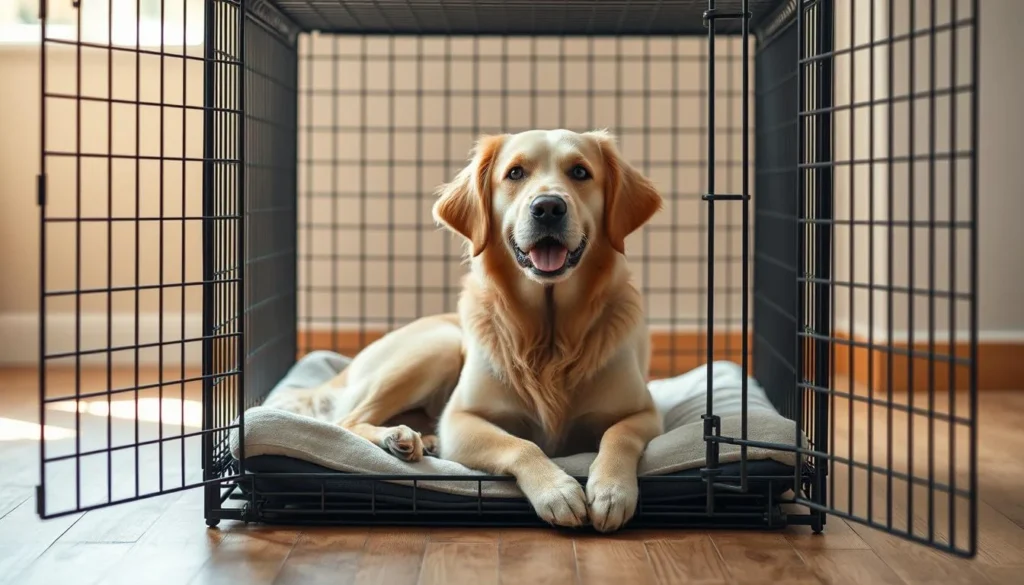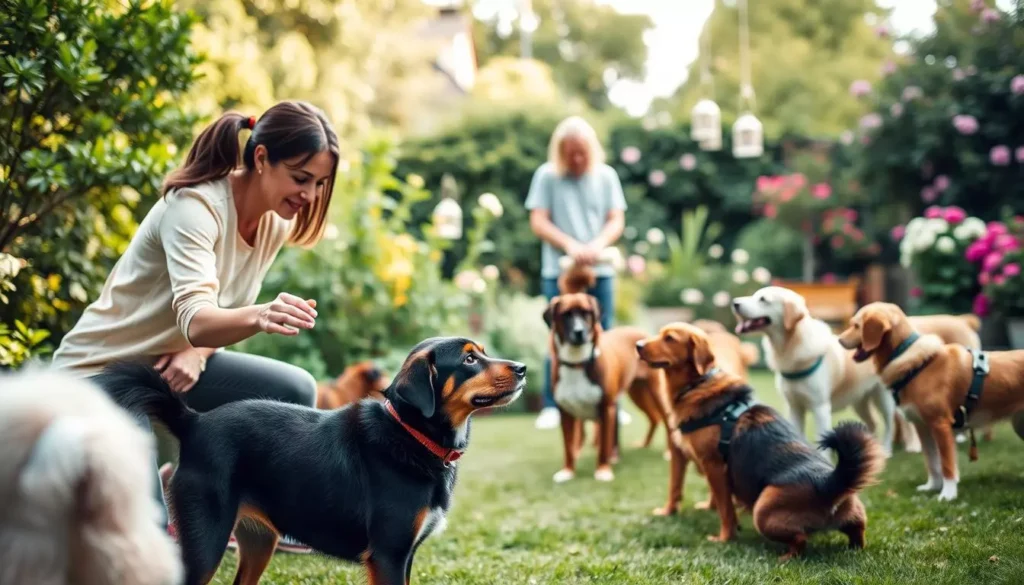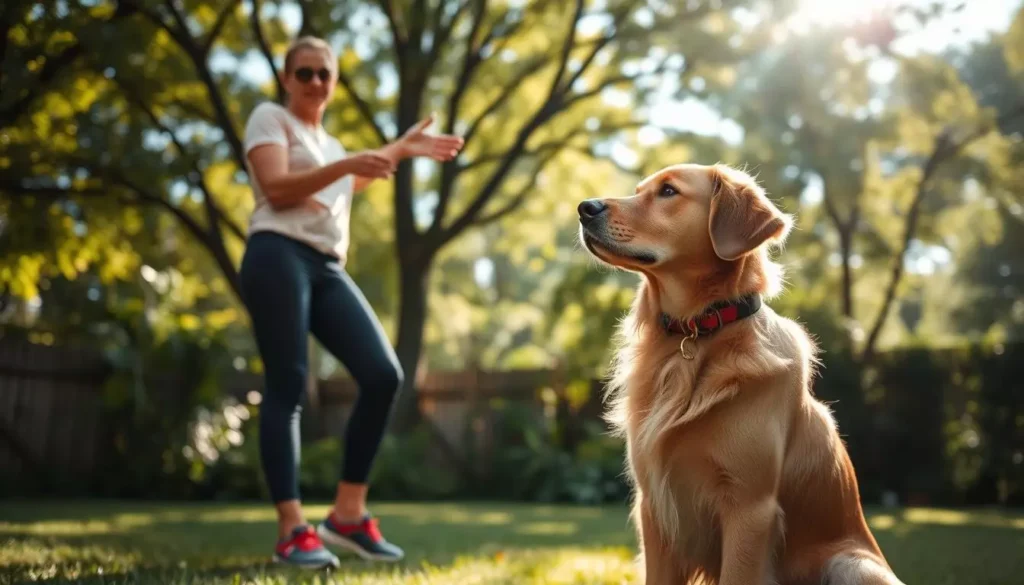I still remember the first time my neighbor's Labrador froze over a dropped piece of pizza. It snarled when I reached for it with a towel. That moment made me rethink everything I knew about dog behavior. If you've felt that same worry and love, you're not alone.
Many of us face how to correct food aggression in dogs. We want to protect our families and pets while restoring trust.
In this article, I'll guide you through the causes, signs, and safety steps. I'll also show you a step-by-step plan using desensitization and counterconditioning. This will help you learn how to correct dog food aggression safely.
I'll explain practical management, like separate feeding spaces and routines. I'll also introduce a seven-stage bowl program and the "All Good Things" game. These methods come from veterinary behavior literature and expert guidance.
Safety is my top priority. If your dog has bitten or escalates during exercises, seek help from a Certified Applied Animal Behaviorist (CAAB/ACAAB) or a boarded veterinary behaviorist (Dip ACVB). Or, a Certified Professional Dog Trainer (CPDT) with aggression experience is also a good choice.
Throughout, I'll focus on training food aggressive dog responses. I'll also show you how to change aggressive dog behavior. This way, every family member can practice the steps consistently.
Key Takeaways
- Food guarding ranges from mild warning signals to biting and not every case needs the same approach.
- Immediate management—separate bowls, gates, and predictable routines—keeps everyone safe while you train.
- Behavior change centers on desensitization and counterconditioning done in progressive stages.
- Professionals like CAABs, Dip ACVBs, or CPDTs should be involved if biting or rapid escalation occurs.
- Consistency among all household members is essential for how to correct dog food aggression to work.
Understanding food aggression and resource guarding in dogs
Many owners ask me about food aggression and when it turns dangerous. I explain that guarding is a way dogs communicate. They use body language and sounds to protect valued items. If we ignore these signs, their behavior can quickly get worse.
Food aggression happens when a dog gets aggressive when someone tries to approach while it's eating. Resource guarding is when a dog defends not just food, but also toys, resting spots, or even people. Knowing these terms helps owners spot the problem early and prevent it from getting worse.
Dogs guard because it helped their ancestors survive. Today, they still have this instinct. Things like competition in puppyhood, stress from shelters, and unpredictable food access can make guarding worse.
Medical issues and hormones also play a part. Hunger and health problems can make a dog more protective of food. Before starting training, it's important to check with a vet to rule out any health issues.
Triggers for guarding are often overlooked. Things like bowls, high-value chews, and table scraps can spark aggression. Dogs may also guard items they've stolen or the wrappers that smell like food. It's crucial for owners to identify these triggers to manage the risk while training their dogs.
It's important to see guarding as a spectrum. Early signs like staring or freezing are warnings. Ignoring these can lead to more serious behavior like growling, snapping, or lunging. Training aims to change these outcomes and stop aggression in a safe and humane way.
| Issue | Typical Signs | Immediate Owner Action |
|---|---|---|
| Early guarding | Stiffening, staring, minor lip lift | Give space, note context, avoid sudden movements |
| Moderate guarding | Low growl, snarl, brief snap | Separate dog, remove high-value items, consult trainer |
| Severe guarding | Repeated lunging, bites with force | Seek professional behaviorist and vet assessment |
| Common triggers | Bowls, chews, counters, garbage, human food | Secure items, supervise, use barriers during feeding |
Recognizing signs and levels of severity of food aggression
I keep a close eye on dogs during meals to catch early warning signs. I watch for small changes in how they stand and act. This helps me stop food aggression before it gets worse.
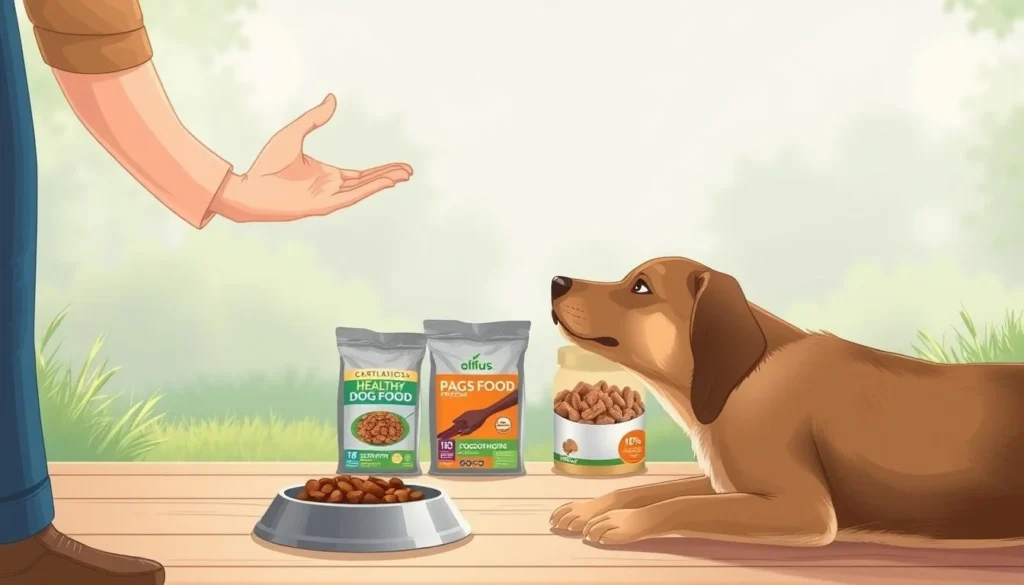
I identify three levels of behavior: mild warnings, more serious displays, and dangerous aggression. Knowing these helps me manage and train the dog better.
Subtle warning signs to watch for
Small changes can signal a dog is feeling uneasy. I look for stiffening, eating fast, and hard stares. These are signs to watch out for.
These signs might include slight body tension and interrupted eating. They are the dog's way of saying "stay away." Ignoring these signs can lead to more serious problems.
Moderate signals
If I miss the early signs, dogs may start making louder warnings. I listen for growling, snarling, and teeth baring. They might also lunge when someone gets too close.
These behaviors need firm action. I keep the dog away and avoid reaching into their bowl. Consistent training can help change these behaviors.
Severe behaviors and bite risk — when to seek professional help
Severe cases include biting and chasing people or other dogs. Any bite attempt means it's time to seek professional help.
Factors that can make aggression worse include forcing the dog and not following a routine. If a dog has bitten before or shows extreme fear, I call a CAAB, Dip ACVB, or CPDT expert in aggression.
I never yell at or confront an aggressive dog. My first step is to quietly leave the area, set up barriers, and work with a professional to create a behavior plan.
| Severity Level | Common Signs | Immediate Action |
|---|---|---|
| Subtle | Stiffening, gulping, staring, interrupted eating | Observe, increase distance, note triggers |
| Moderate | Growling, snarling, snapping, lunging | Separate parties, avoid testing, start controlled training |
| Severe | Biting, chasing, sustained attacks | Seek CAAB/Dip ACVB/CPDT, implement strict management |
I use phrases like signs food aggression dogs, how to correct food aggression in dogs towards humans, and how to correct food aggression in dogs towards other dogs when planning solutions. These phrases help me choose the right management for safety and good interactions between pets and humans.
Immediate safety and management strategies to prevent incidents
When a dog guards food, safety is key. I use simple barriers and clear rules. This helps everyone know what to do while we work on changing the dog's behavior.
Short-term management: separate feeding areas, gates, crates and barriers
I keep dogs apart during meals with closed doors, gates, crates, or barriers. I place their bowls in different rooms or at opposite ends of a large room. If a dog finishes, I pick up the bowl right away to avoid guarding.
I also block counters and garbage with closed doors and lidded bins. For fast eaters, slow-feeder bowls help during training.
Household rules to reduce risk around children and guests
I teach families to never approach a dog while it's eating. They should never take food or toys during meals. I tell everyone to ask before touching a dog.
If a guest has food, the dog should be in another room. I advise against training dogs with guarding tendencies to people under 18. This keeps everyone safe and training consistent.
Feeding routines and environment changes to minimize guarding
I switch to scheduled meals to reduce hunger-driven guarding. If a dog seems overly food-driven, a vet check is recommended. Medical issues can cause guarding behavior.
During training, I use temporary measures like tethering or barriers. These steps ensure safety until the dog eats calmly.
| Strategy | Action | Goal |
|---|---|---|
| Separate feeding | Feed in separate rooms, behind gates, or in crates | Reduce competition and immediate conflict |
| Pick up bowls | Remove empty dishes immediately after meals | Prevent guarding of residual food and resources |
| Control access | Close doors, use lidded bins, block counters | Limit dog access to human food and tempting areas |
| Visitor rules | Confine dog when guests eat or remove dog from food areas | Protect guests and reduce triggers |
| Meal routine | Scheduled portions, slow-feeders, vet check for hunger | Stabilize hunger and reduce resource guarding drive |
| Temporary training safety | Use tethers and barriers to maintain distance during exercises | Keep people safe while training how to correct dog food aggression |
| Household education | Teach kids and guests rules about approaching dogs | Create predictable, low-stress feeding environment |
Prevention tactics for puppies and newly adopted dogs
I welcome every new puppy or rescue with calm, predictable routines. Early habits shape a dog's relationship with food. I focus on gentle, step-by-step practices that teach trust and reduce the need to guard resources.
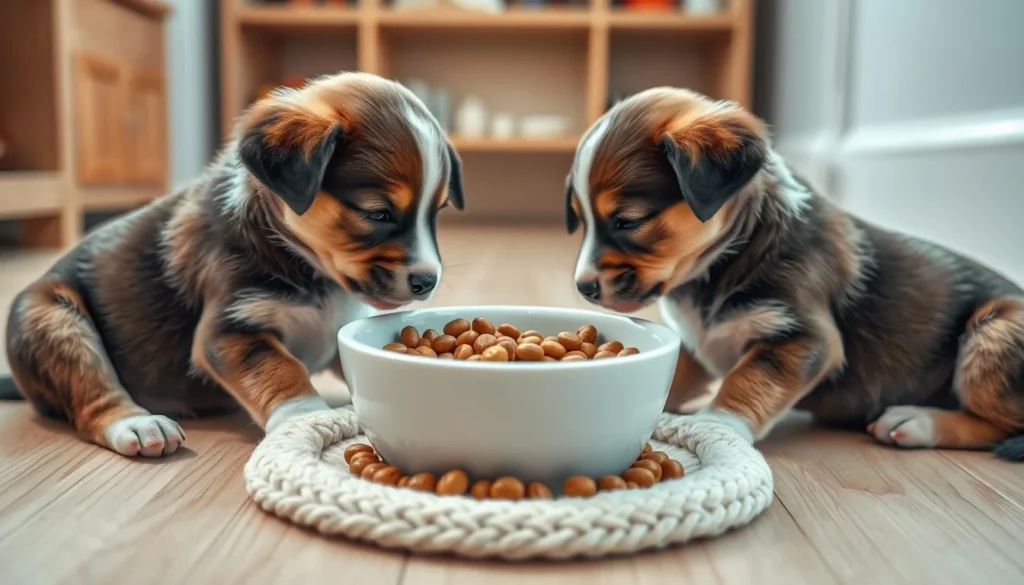
I start with hand-feeding several meals. I offer kibble one piece at a time while I speak softly and pet the puppy. Next, I hold the bowl in my lap for a few feeds. Then I place it on the floor and intermittently add a high-value treat. This shows the puppy that people bring good things during meals and helps with how to train food aggressive dog behaviors later.
I use the “All Good Things” idea to make human presence positive. I walk by at a comfortable distance and toss a tasty bite. Over days I close the gap as the dog stays relaxed. These small actions teach the dog to expect rewards when people approach, which helps prevent food aggression puppies from developing.
I set strict mealtime routines. I feed on a schedule, with individual bowls in separate spaces when more than one dog lives in the home. I avoid table scraps and never hand over human food unpredictably. Clear rules cut down competition and make it easier to learn how to train aggressive dogs without confrontation.
Breeders and shelters can limit guarding by avoiding large communal pans during weaning. I recommend spaced bowls, careful monitoring, and enrichment that keeps pups occupied. Ensuring equal access and supervising mealtimes reduces the chance one pup monopolizes resources and lowers the need to learn how to train food aggressive dog responses later.
I caution against repeatedly snatching a bowl to “test” a puppy. That teaches fear and escalation. If I see stiffening, staring, or a subtle growl, I back off and use positive-conditioning steps instead. These preventive actions protect both people and pets as they grow together.
Behavior modification approach: desensitization and counterconditioning
I guide you through a step-by-step plan to change your dog's food aggression. It combines desensitization and counterconditioning. This way, you can safely change your dog's behavior at home.
First, we learn the basics. Desensitization makes your dog less sensitive by slowly introducing people near the bowl. Counterconditioning adds something positive, making your dog look forward to these interactions.
Start by standing far away while your dog eats. Give them treats like chicken, beef, or cheese near the bowl. Only move closer when they eat calmly for about ten meals at each step.
I explain how to pace the steps. Move closer just a little bit each day. If your dog stiffens or shows signs of stress, go back a step or pause until they calm down. This careful approach helps change their behavior safely.
It's important to watch your dog's body language. Look for signs of calmness like relaxed posture and steady eating. But, if you see tensing or hard staring, stop and get help.
I suggest choosing the right treats and how to handle them. Use special foods to keep them exciting. Keep the treats small for more practice. Make sure everyone in the family follows the same steps. Use tools like tethers or gates for safety when needed.
Finally, here's a quick checklist for training:
- Start at a calm distance and deliver super-high-value treats.
- Require ten relaxed meals before moving closer.
- Monitor body language; back up at the first sign of stress.
- Keep sessions short, frequent, and predictable.
- Use safety tools like tethers and gates when appropriate.
Step-by-step training stages for changing guarding reactions
I'll guide you through a seven-step plan to fix food aggression in dogs. Each step builds on the last. I keep training short, calm, and tied to regular meal times. This helps the dog learn to relax instead of worry.
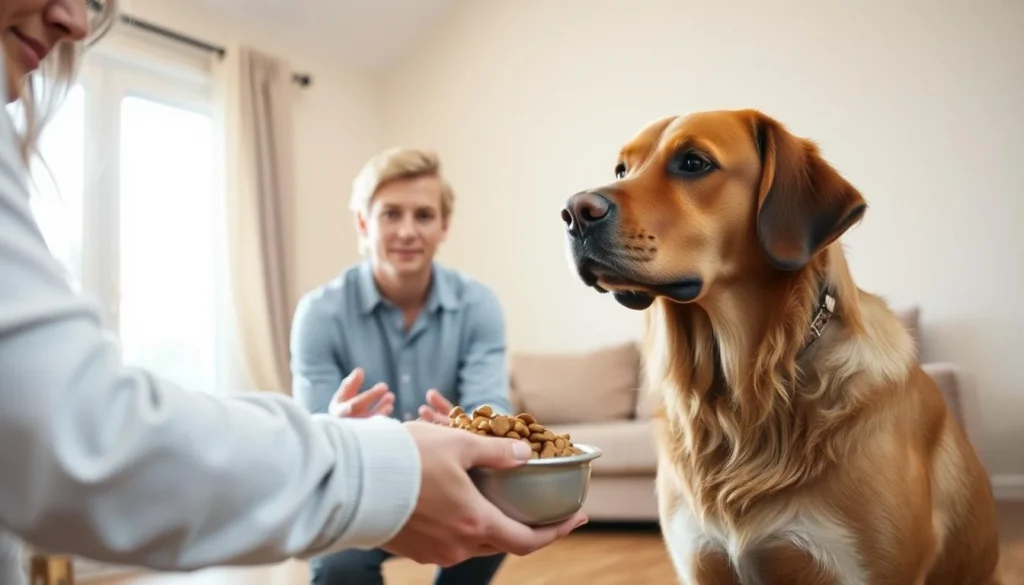
I start with tossing treats from a distance and end with safe bowl handling by family members. The goal is to make steady progress. We use stage training and the all good things game to make humans seem friendly, not scary.
Stage One: Stand a few feet away and toss a special treat towards the bowl while saying a neutral cue. Do this every few seconds until the dog eats calmly for about ten meals.
Stage Two: Step closer briefly, toss the treat, then step back. Do this daily and move closer each day. Aim to stand about two feet away while the dog stays calm for ten meals.
Stage Three: Stand next to the bowl and drop treats into it while saying the cue, then immediately turn and walk away. Repeat until the dog eats calmly for ten meals.
Stage Four: Offer treats from your hand beside the bowl, starting by bending slightly. Encourage the dog to take treats, then walk away. Gradually bend lower until your hand is at bowl level.
Stage Five: Touch the bowl with one hand while offering treats with the other without removing food. Continue until the dog remains relaxed during ten meals.
Stage Six: Lift the bowl slightly (6–12 inches), add a treat, and return it. Slowly raise the bowl higher, then carry it to a counter and bring it back to the same spot as the dog stays calm.
Stage Seven: Have every adult family member repeat stages one through six. This helps the dog generalize relaxed responses to all people in the home.
I use the all good things game as a running exercise. Walk by at a comfortable distance, announce a cue like “bonus,” and toss a high-value treat before moving away. The cue predicts a reward whenever someone approaches, creating positive anticipation.
If the dog shows any warning sign such as stiffening, gulping, or fixed staring, I stop and step back to the prior comfortable stage. If stress repeats or the dog refuses food, I pause the program and recommend consulting a certified behaviorist.
When aggression exists already, I work behind barriers or gates and keep sessions slower. Professionals may add voice cues, longer timelines, or different barriers for safety. I always use treats that are higher value than the bowl’s contents and keep training calm and brief.
When food aggression is directed toward humans and how to address it
I work with owners who face human-directed guarding every week. This type of guarding can be dangerous because a dog that guards food from a person may escalate quickly. Children and visitors are often at highest risk since they may not notice early warning signs.
I recommend immediate safety steps first. Remove children from the area during meals and confine the dog to a separate room, crate, or behind a baby gate while people eat. Keep human food out of common spaces when the dog is present. These actions reduce the chance of an incident while you work on behavior change.
Train with adjustments that prioritize safety. Adults should handle desensitization and counterconditioning using high-value treats and a slow, predictable routine. Use tethering, crates, or gates to maintain a buffer during exercises. Never have a child perform close-proximity drills. Clear, consistent boundaries and stepwise progress help when you stop food aggression dogs from escalating.
Medical issues can drive guarding. I urge owners to have a full veterinary exam to rule out pain, illness, or hormonal causes. Spaying or neutering may reduce some hormonally linked aggression. A combined veterinary and behavioral plan gives the best chance to change the behavior safely.
Professional help is essential in many cases. Contact a CAAB, a Dip ACVB diplomate, or a certified CPDT who has aggression experience if your dog has bitten or attempted to bite, or if you feel unsafe. These professionals design individualized programs. They can include controlled training, safety protocols, and coordination with your veterinarian.
Document every incident and every professional recommendation. Keep records of bites, warnings, and your trainer’s plan. This practice helps with legal and ethical decisions and guides whether rehoming or long-term management is needed when efforts to stop food aggression dogs do not reduce risk.
| Situation | Immediate Action | Who Should Train | When to Seek Specialist |
|---|---|---|---|
| Dog growls at a visitor near a bowl | Remove visitor, place dog in crate, move bowl | Adult trainer using barriers and high-value treats | If growling escalates or repeats |
| Dog lunges when a child approaches food | Keep child away, separate feeding area, restrict access | Qualified CPDT or CAAB; children excluded from exercises | After any lunge or bite towards a person |
| Dog snaps when hands near plate on counter | Remove people from kitchen, confine dog during food prep | Experienced behaviorist with veterinary collaboration | If attempts to bite continue despite management |
When food aggression is directed toward other dogs and multi-dog households
I help families with multiple dogs who struggle with food aggression. First, I make sure there's no competition during meals. This means setting up clear routines, using separate bowls, and creating barriers for each dog to eat peacefully.
For managing meals in a multi-dog home, I teach owners simple strategies. These include staggered meal times, eating in separate rooms, and using baby gates or crates. I also advise removing empty bowls quickly to prevent guarding and to only give high-value chews during supervised times.
Training in a multi-dog setting requires careful planning. I start by training one dog at a time. I use exercises that help them relax when they're not with other dogs. Only when both dogs are calm alone do we practice being close together.
Breeders and shelters need to follow strict feeding and socialization plans. I recommend feeding each puppy individually to avoid early guarding. Watch littermates closely and separate them if you see any guarding behavior.
It's crucial to supervise when giving out special treats or toys. I suggest using long lines, barriers, or separate areas for these items. Never take away items in front of another dog, and avoid letting a dog practice guarding. If problems get worse, it's time to seek help from a certified behavior expert.
Here's a quick guide for mealtime decisions:
| Situation | Recommended Setup | Why it helps |
|---|---|---|
| Two calm dogs, no history of guarding | Visual separation with baby gate or separate bowls in same room | Maintains distance while allowing neutral supervision |
| One dog shows mild guarding signs | Separate rooms or crates for meals; staggered feeding times | Removes competition and prevents escalation |
| Active inter-dog guarding or resource fights | Full separation during feeding; training one dog at a time | Protects safety and allows focused desensitization work |
| High-value chews or toys | Use supervised sessions with barriers; remove when done | Prevents rehearsed guarding and reduces triggers |
| Shelter or breeder group feeding | Individual bowls, monitored rotation, avoid communal pans | Ensures fair access and detects early guarding patterns |
Common mistakes, myths and what not to do
Many owners make mistakes that make guarding worse. This guide will show you what not to do in food aggression situations.
Don't use punishment or intimidation. Scolding, hitting, or trying to dominate can make things worse. It teaches dogs that people are threats, leading to more guarding.
Don't grab a bowl or test a dog during meals. It can make them more alert and might lead to biting. Instead, focus on calm, planned exercises to change behavior.
Hand-feeding can be tricky. It can build trust if done gently and briefly. But, using it as a tool to take food away can make guarding worse. I suggest slow, positive pairings.
Long obedience sequences before meals are a myth. Forcing dogs to do many tasks to get food can be frustrating. Short, clear exercises tied to positive outcomes work better.
Be careful with puppies. Disturbing them during meals can teach guarding early. Use the All Good Things approach: drop a treat near a puppy to make human presence positive.
To train aggressive dogs, focus on gradual desensitization and counterconditioning. Pair small, non-threatening actions with treats and retreat before stress. Also, use consistent management and veterinary checks.
For safety, use simple rules at home. Separate feeding zones, supervise interactions, and prevent access to valuable items until training improves. If signs get worse, consult a certified animal behaviorist or a CPDT-certified trainer for a tailored plan.
| Common Mistake | Why It Backfires | Better Option |
|---|---|---|
| Scolding, hitting, dominance | Increases fear and guarding; damages trust | Use calm counterconditioning and consult a behaviorist |
| Frequent bowl snatching or testing | Teaches vigilance and may provoke bites | Manage access and practice low-stress desensitization |
| Misapplied hand-feeding | Can reinforce guarding if intrusive | Use brief, voluntary hand-feeding tied to positive rewards |
| Long cue chains before meals | Creates frustration; not evidence-based for guarding | Short, predictable routines and positive reinforcement |
| Disturbing puppies while they eat | May teach early guarding behaviors | Use gentle exposure like dropping treats and praise |
Conclusion
I've shared steps to fix food aggression in dogs. First, ensure safety and manage situations. Then, check for health issues with your vet. Use slow steps to change how dogs react to food.
Tools like separate eating spots and gates help. They give you time to train without risks. This way, you can work on changing their behavior calmly.
When training starts, go slow and watch your dog's body language. Use treats and positive actions to teach them. It's key that everyone in the house does things the same way. This makes training faster and more effective.
Don't use punishment or take food away. These methods can make things worse. If your dog's behavior is serious or they've bitten before, get help from experts. With the right help and patience, you can teach your dog to be calm during meals.


